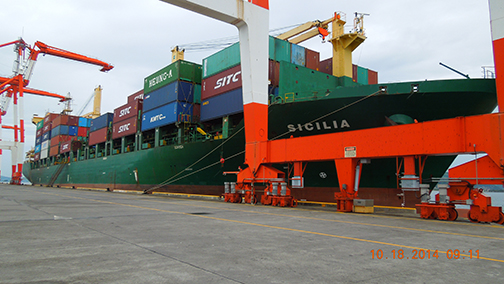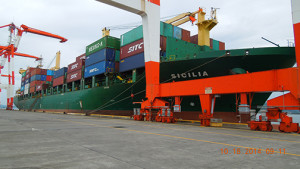

The Subic Bay Metropolitan Authority (SBMA) is expecting more ship calls at Subic port within the next few weeks, expressing hope this will eventually lead to a doubling of cargo volume at the northern Luzon shipping hub.
“We’ve been informed that within the next two weeks or so, there will be more ships that will be coming to unload at Subic,” SBMA chairman Roberto Garcia said in a statement.
Garcia, in a later text message to PortCalls, said while SITC Line recently started connecting Subic to Xiamen, other carriers eyeing to link Subic specifically to Japan and Singapore will start calling “hopefully (at the) latest first quarter next year.”
SITC’s MV Sicilia 1436S, which has a capacity of 1,800 twenty-foot equivalent units (TEUs), called Subic’s New Container Terminal (NCT) 2 on October 17. It unloaded 22 containers laden with products from the Chinese cities of Guangxi, Sichuan and Shanghai, consigned to Orica Philippines in Limay, Bataan; Nestle Philippines in Cabuyao, Laguna; and Manila World Transport in Metro Manila.
SBMA Seaport Department general manager Jerome Martinez said three more foreign container ships will soon be arriving in Subic direct from their origin.“They are not diverted vessels from the Port of Manila as a result of port congestion. They really are to come to Subic as part of their itinerary,” Martinez pointed out.
SBMA noted that Japanese carrier NYK Line is seriously looking at establishing a Subic-Singapore route to connect to Europe, Africa and Middle East to exporters and importers.
Shippers are now starting to look at Subic as an alternative after the Manila daytime truck ban caused massive congestion at Manila ports. While the truck ban has been lifted, its effects linger.
Earlier, Garcia reported on the proposal to create a direct Shanghai-Subic route to open up ports in China, instead of passing through Kaohsiung in Taiwan. Right now, the two direct Subic callers, APL and Wan Hai, call Kaohsiung.
Garcia hopes the cargo volume at Subic’s container port will grow to more than 70,000 TEUs this year from 38,000 twenty-foot equivalent units last year.
From January to August this year, NCT 1 handled 34,746.25 TEUs, 54.86% higher than the 22,437.75 TEUs handled in the same period last year, and only a few thousand short of the overall 2013 volume of 38,000 TEUs.
In preparation for the expected increase in traffic flow to Subic Bay Freeport, SBMA recently hosted a “Traffic Safety Forum” to find ways to prevent a traffic build-up along the main route taken by cargo trucks at the Freeport.
“Let us all cross our fingers that things turn out for the best for Subic,” Garcia said, stressing that Subic is the only port on the western seaboard of the Philippines that currently has the capacity to accept a great volume of containers.
He added that if Subic gets congested because of heavy container traffic, it will be a “happy problem” for the SBMA.




